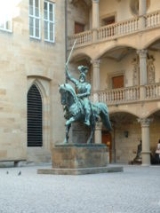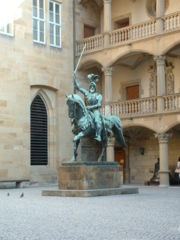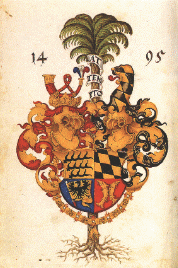
Eberhard I, Duke of Württemberg
Encyclopedia
Eberhard I of Württemberg (11 December 1445, Urach
– 24 February 1496, Tübingen
). From 1459 till 1495 he was Count
Eberhard V. From July 1495 he was the first Duke of Württemberg
. He is also known as Eberhard im Bart (Eberhard the Bearded).



and his wife Mechthild of the Palatinate, born as countess palatine
by the Rhine. He was first buried in the collegiate church
Saint Peter auf dem Einsiedel, later in the collegiate church of Tübingen
.
Count Eberhard V officially took charge of government of Württemberg-Urach as an underage. Württemberg was divided since 1442. At first he had a legal guardian, a respected nobleman who had mentored his father as a youth, Rudolph von Ehingen of Kilchberg
. In 1468 he travelled to Jerusalem and became a knight of the Order of the Holy Sepulchre
. To commemorate this he chose the palm as his symbol.
In Urach on 12 April (or 4 July) 1474 he married a prestigious bride, Barbara, daughter of Ludovico II Gonzaga, Marquis of Mantua and member of a very rich and respected Italian family. The only daughter out of this marriage, Barbara, was born in Urach on 2 August 1475 and died on 15 October of that year.
In 1477, count Eberhard, whose motto was "attempto" (I dare), founded the University of Tübingen
. He invited the Brethren of the Common Life
and the community of devotio moderna
to his country and founded collegiate churches in Urach, Dettingen an der Erms
, Herrenberg
, Einsiedel near Tübingen and Tachenhausen.
He took interest in reforms of the church and monasteries. Despite not being able to speak Latin he held education in high esteem and had a great number of Latin texts translated into German. Parts of his large library have been preserved.
Finally on December 14, 1482, he achieved the re-unification of the two parts of Württemberg, Württemberg-Urach and Württemberg-Stuttgart, with the Treaty of Münsingen
. He moved the capital to Stuttgart
and ruled the re-united country. In the same year Pope Sixtus IV
awarded him the Golden Rose
. In 1492 he was awarded the Order of the Golden Fleece
, by Maximilian I
, then King of Germany.
On July 21, 1495 count Eberhard V was declared Duke of Württemberg on the Reichstag
in Worms
by Maximilian I. At that time his new title (in German, "Herzog") denoted a large measure of sovereignty
within the Holy Roman Empire
, just below that of "Elector
".
Johannes Nauclerus
, a humanist and historian, served at his court.
.
In the Swabian anthem
"Preisend mit viel schönen Reden" by Justinus Kerner
, he is praised as: "Eberhard the one with the beard, Württemberg's beloved ruler." In this so-called song of the Württembergians, he is praised as the richest prince amongst the German princes, as he is able to rest his head on the lap of every one of his subjects without having fear for his life or property.
He is considered one of the greatest rulers of Württemberg.
Bad Urach
Bad Urach is a town in the district of Reutlingen, Baden-Württemberg, Germany. It is situated 14 km east of Reutlingen, at the foot of the Swabian Alb, and is known for its spa and therapeutic bath.-History:...
– 24 February 1496, Tübingen
Tübingen
Tübingen is a traditional university town in central Baden-Württemberg, Germany. It is situated south of the state capital, Stuttgart, on a ridge between the Neckar and Ammer rivers.-Geography:...
). From 1459 till 1495 he was Count
Graf
Graf is a historical German noble title equal in rank to a count or a British earl...
Eberhard V. From July 1495 he was the first Duke of Württemberg
Württemberg
Württemberg , formerly known as Wirtemberg or Wurtemberg, is an area and a former state in southwestern Germany, including parts of the regions Swabia and Franconia....
. He is also known as Eberhard im Bart (Eberhard the Bearded).



Life
He was the son of count Ludwig ILudwig I, Count of Württemberg-Urach
Ludwig I , Count of Württemberg. He was a son of count Eberhard IV and Henriette of Montbéliard. He reigned from 1419 until 1450....
and his wife Mechthild of the Palatinate, born as countess palatine
Count palatine
Count palatine is a high noble title, used to render several comital styles, in some cases also shortened to Palatine, which can have other meanings as well.-Comes palatinus:...
by the Rhine. He was first buried in the collegiate church
Collegiate church
In Christianity, a collegiate church is a church where the daily office of worship is maintained by a college of canons; a non-monastic, or "secular" community of clergy, organised as a self-governing corporate body, which may be presided over by a dean or provost...
Saint Peter auf dem Einsiedel, later in the collegiate church of Tübingen
Tübingen
Tübingen is a traditional university town in central Baden-Württemberg, Germany. It is situated south of the state capital, Stuttgart, on a ridge between the Neckar and Ammer rivers.-Geography:...
.
Count Eberhard V officially took charge of government of Württemberg-Urach as an underage. Württemberg was divided since 1442. At first he had a legal guardian, a respected nobleman who had mentored his father as a youth, Rudolph von Ehingen of Kilchberg
Kilchberg (Tübingen)
Kilchberg is a village within the administrative district of Tübingen. Kilchberg is located 2.6 miles south west of the city center, and is situated along the south bank of the Neckar River in Baden-Württemberg, Germany...
. In 1468 he travelled to Jerusalem and became a knight of the Order of the Holy Sepulchre
Order of the Holy Sepulchre
The Equestrian Order of the Holy Sepulchre of Jerusalem is a Roman Catholic order of knighthood under the protection of the pope. It traces its roots to Duke Godfrey of Bouillon, principal leader of the First Crusade...
. To commemorate this he chose the palm as his symbol.
In Urach on 12 April (or 4 July) 1474 he married a prestigious bride, Barbara, daughter of Ludovico II Gonzaga, Marquis of Mantua and member of a very rich and respected Italian family. The only daughter out of this marriage, Barbara, was born in Urach on 2 August 1475 and died on 15 October of that year.
In 1477, count Eberhard, whose motto was "attempto" (I dare), founded the University of Tübingen
Eberhard Karls University of Tübingen
Eberhard Karls University, Tübingen is a public university located in the city of Tübingen, Baden-Württemberg, Germany. It is one of Germany's oldest universities, internationally noted in medicine, natural sciences and the humanities. In the area of German Studies it has been ranked first among...
. He invited the Brethren of the Common Life
Brethren of the Common Life
The Brethren of the Common Life was a Roman Catholic pietist religious community founded in the 14th century by Gerard Groote, formerly a successful and worldly educator who had had a religious experience and preached a life of simple devotion to Jesus Christ...
and the community of devotio moderna
Devotio Moderna
Devotio Moderna, or Modern Devotion, was a 14th century new religious movement, with Gerard Groote as a key founder. Other well known members included Thomas à Kempis who was the likely author of the book The Imitation of Christ which proved to be highly influential for centuries.Groote's initial...
to his country and founded collegiate churches in Urach, Dettingen an der Erms
Dettingen an der Erms
Dettingen an der Erms is a town in the district of Reutlingen in Baden-Württemberg in Germany....
, Herrenberg
Herrenberg
Herrenberg is a town in the middle of Baden-Württemberg, about 30 kmsouth of Stuttgart and 20 km from Tübingen. After Sindelfingen, Böblingen, and Leonberg, it is the fourth largest town in the district of Böblingen...
, Einsiedel near Tübingen and Tachenhausen.
He took interest in reforms of the church and monasteries. Despite not being able to speak Latin he held education in high esteem and had a great number of Latin texts translated into German. Parts of his large library have been preserved.
Finally on December 14, 1482, he achieved the re-unification of the two parts of Württemberg, Württemberg-Urach and Württemberg-Stuttgart, with the Treaty of Münsingen
Treaty of Münsingen
The Treaty of Münsingen was signed on December 14, 1482. This accord officially re-united the divided county of Württemberg after it was divided by the Treaty of Nürtingen in 1442. The hereditary dispute between the Stuttgart part and the part of Urach were settled after 40 years...
. He moved the capital to Stuttgart
Stuttgart
Stuttgart is the capital of the state of Baden-Württemberg in southern Germany. The sixth-largest city in Germany, Stuttgart has a population of 600,038 while the metropolitan area has a population of 5.3 million ....
and ruled the re-united country. In the same year Pope Sixtus IV
Pope Sixtus IV
Pope Sixtus IV , born Francesco della Rovere, was Pope from 1471 to 1484. His accomplishments as Pope included the establishment of the Sistine Chapel; the group of artists that he brought together introduced the Early Renaissance into Rome with the first masterpiece of the city's new artistic age,...
awarded him the Golden Rose
Golden Rose
The Golden Rose is a gold ornament, which popes of the Catholic Church have traditionally blessed annually. It is occasionally conferred as a token of reverence or affection...
. In 1492 he was awarded the Order of the Golden Fleece
Order of the Golden Fleece
The Order of the Golden Fleece is an order of chivalry founded in Bruges by Philip III, Duke of Burgundy in 1430, to celebrate his marriage to the Portuguese princess Infanta Isabella of Portugal, daughter of King John I of Portugal. It evolved as one of the most prestigious orders in Europe...
, by Maximilian I
Maximilian I, Holy Roman Emperor
Maximilian I , the son of Frederick III, Holy Roman Emperor and Eleanor of Portugal, was King of the Romans from 1486 and Holy Roman Emperor from 1493 until his death, though he was never in fact crowned by the Pope, the journey to Rome always being too risky...
, then King of Germany.
On July 21, 1495 count Eberhard V was declared Duke of Württemberg on the Reichstag
Reichstag (Holy Roman Empire)
The Imperial Diet was the Diet, or general assembly, of the Imperial Estates of the Holy Roman Empire.During the period of the Empire, which lasted formally until 1806, the Diet was not a parliament in today's sense; instead, it was an assembly of the various estates of the realm...
in Worms
Worms, Germany
Worms is a city in Rhineland-Palatinate, Germany, on the Rhine River. At the end of 2004, it had 85,829 inhabitants.Established by the Celts, who called it Borbetomagus, Worms today remains embattled with the cities Trier and Cologne over the title of "Oldest City in Germany." Worms is the only...
by Maximilian I. At that time his new title (in German, "Herzog") denoted a large measure of sovereignty
Sovereignty
Sovereignty is the quality of having supreme, independent authority over a geographic area, such as a territory. It can be found in a power to rule and make law that rests on a political fact for which no purely legal explanation can be provided...
within the Holy Roman Empire
Holy Roman Empire
The Holy Roman Empire was a realm that existed from 962 to 1806 in Central Europe.It was ruled by the Holy Roman Emperor. Its character changed during the Middle Ages and the Early Modern period, when the power of the emperor gradually weakened in favour of the princes...
, just below that of "Elector
Prince-elector
The Prince-electors of the Holy Roman Empire were the members of the electoral college of the Holy Roman Empire, having the function of electing the Roman king or, from the middle of the 16th century onwards, directly the Holy Roman Emperor.The heir-apparent to a prince-elector was known as an...
".
Johannes Nauclerus
Johannes Nauclerus
Johannes Nauclerus was a 16th century Swabian historian and humanist. He was born Johann Vergenhans to a noble man of the same name...
, a humanist and historian, served at his court.
Reception
Already his contemporaries admired his intellectual strength. In the 19th and 20th century the patriotic historiography transfigured him. A bust of him was erected in WalhallaWalhalla temple
The Walhalla temple is a hall of fame that honors laudable and distinguished Germans, famous personalities in German history — politicians, sovereigns, scientists and artists of the German tongue". The hall is housed in a neo-classical building above the Danube River, east of Regensburg, in...
.
In the Swabian anthem
Anthem
The term anthem means either a specific form of Anglican church music , or more generally, a song of celebration, usually acting as a symbol for a distinct group of people, as in the term "national anthem" or "sports anthem".-Etymology:The word is derived from the Greek via Old English , a word...
"Preisend mit viel schönen Reden" by Justinus Kerner
Justinus Kerner
Justinus Andreas Christian Kerner was a German poet and medical writer.-Life:He was born at Ludwigsburg in Württemberg...
, he is praised as: "Eberhard the one with the beard, Württemberg's beloved ruler." In this so-called song of the Württembergians, he is praised as the richest prince amongst the German princes, as he is able to rest his head on the lap of every one of his subjects without having fear for his life or property.
He is considered one of the greatest rulers of Württemberg.
Literature
- Ernst, Fritz. Eberhard im Bart: Die Politik eines deutschen Landesherrn am Ende des Mittelalters. Stuttgart, 1933.
- Maurer, Hans-Martin, ed. Eberhard und Mechthild: Untersuchungen zu Politik und Kultur im ausgehenden Mittelalter. Untersuchungen zu Politik und Kultur im ausgehenden Mittelalter (Lebendige Vergangenheit: Zeugnisse und Erinnerungen. Schriftenreihe des Württembergischen Geschichts- und Altertumsvereins, Band 17). Stuttgart, 1994.
- Mertens, Dieter. Eberhard V./I. im Bart. In Das Haus Württemberg: Ein biographisches Lexikon. ed. Sönke Lorenz, Dieter Mertens, & Volker PressVolker PressVolker Press was a German historian.-Life and career:Volker Press studied history and English from 1957 to 1965 at the University of Munich. He completed his doctorate in 1966 with Friedrich Hermann Schubert with a dissertation on the Electoral Palatinate in the confessional age...
. Stuttgart, 1997. pp. 92-95. - Mertens, Dieter. Eberhard im Bart als Stifter der Universität Tübingen. In Sönke Lorenz, et al. eds. Attempto - oder wie stiftet man eine Universität: Die Universitätsgründungen der sogenannten zweiten Gründungswelle im Vergleich (Contubernium Band 50). Stuttgart, 1999. pp. 157-173.
- Württembergische Landesmuseum Stuttgart, ed. Eberhard im Bart, der erste Herzog von Württemberg. Stuttgart, 1990.

